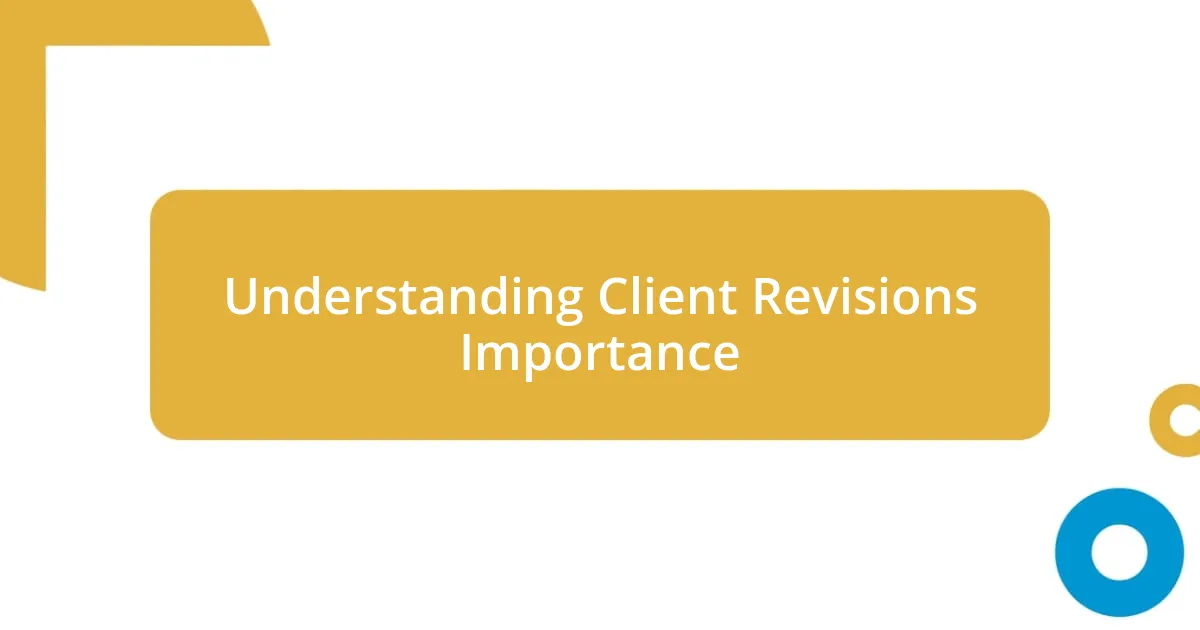Key takeaways:
- Client revisions build trust and enhance creativity, transforming average outputs into exceptional results through collaboration.
- Setting clear expectations and limits upfront minimizes misunderstandings and fosters a stronger partnership with clients.
- Effective communication, including active listening and regular updates, facilitates a smoother revision process and empowers clients to influence project direction.
- Documenting revisions for clarity not only ensures alignment between client and creator but also enhances accountability and reduces stress during the feedback process.

Understanding Client Revisions Importance
Understanding the importance of client revisions goes beyond just making adjustments; it’s about building trust. I remember a project where my first draft received a lot of feedback. Rather than seeing it as criticism, I realized this was my client’s way of wanting to be heard and involved. Wouldn’t you agree that seeing a client engage deeply often leads to a better outcome for both parties?
Revisions can be the turning point in a project, often transforming an okay product into something exceptional. I once worked with a client who had a very particular vision. After a couple of rounds of revisions, not only did their satisfaction soar, but I found myself inspired by their ideas. Isn’t it fascinating how collaboration can spark creativity?
Ultimately, revisions offer a unique opportunity to refine and clarify. I always remind myself that each round of feedback has the potential to bring insights that weren’t clear before. Have you ever noticed how a simple tweak can suddenly redefine the entire direction of a project? In my experience, those moments of revelation are invaluable, making revisions a critical part of the creative process.

Setting Clear Expectations Early
Setting clear expectations right from the start makes a world of difference in how revisions progress. I recall a project where the initial discussion centered around detailed goals and deadlines. Because we laid a solid foundation, it was easier to manage expectations later on when revisions came into play. How often have you found that clarity can eliminate confusion and even frustration?
Another experience I had reinforced the importance of transparency. On a prior project, I realized I hadn’t defined the number of revision rounds at the outset. This oversight caused stress when the client wanted multiple changes that exceeded our initial agreement. It’s amazing how being upfront about such details can set a collaborative tone and prevent potential misunderstandings down the line.
Establishing expectations isn’t just about deliverables; it’s about cultivating that sense of partnership. One time, I asked a client for their preferred communication style and frequency. This simple question turned our relationship from standard to sincere, making every revision feel like a shared journey. It’s this type of connection that can truly elevate the experience for both client and creator.
| Clear Expectations | Potential Issues |
|---|---|
| Defined Goals Early | Misalignment in Vision |
| Set Revision Limits | Excessive Requests |
| Regular Check-Ins | Communication Breakdown |

Effective Communication Strategies
Effective communication is the backbone of managing client revisions. In my journey, I discovered that actively listening to my clients not only helped clarify their needs but also built rapport. During one particular project, I found that instead of responding immediately, allowing space for my client’s thoughts often led to deeper insights. It’s interesting how, by simply being present in the conversation, I could often anticipate concerns before they were voiced.
To enhance communication during the revision process, consider these strategies:
- Active Listening: Make it a priority to listen, ensuring clients feel understood.
- Regular Updates: Keep clients in the loop with timely progress reports.
- Encourage Questions: Foster an environment where clients feel comfortable asking for clarification.
- Visual Aids: Use mock-ups or sketches to illustrate changes, helping make abstract ideas more tangible.
- Feedback Summaries: After discussions, summarize key points to confirm mutual understanding.
By integrating these strategies, I’ve seen a transformation in client relationships. It’s rewarding when clients recognize that their voices genuinely shape the project. Have you ever noticed how these small adjustments in communication can profoundly influence the overall collaboration?

Creating a Revision Process
Creating a revision process is crucial for navigating the often delicate waters of client feedback. I remember a particular project where I decided to implement a structured revision timeline. We agreed on three rounds of revisions upfront, which not only set clear boundaries but also kept both my team and the client focused. Have you ever felt the relief of knowing exactly what to expect? It changes the dynamic entirely.
As the project progressed, I utilized a shared document where both the client and I could track revisions in real time. This transparency was a game changer. I found that when clients could see their feedback in action, it reinforced their trust in my process. There was a moment when a client expressed gratitude for this clarity; it felt like a genuine connection had blossomed thanks to a simple tool. Isn’t it fascinating how a little organization can lead to greater collaboration?
In reflecting on my approach, I realized that checking in with clients between revision rounds was invaluable. One particular client appreciated the brief touchpoints, as it allowed us to recalibrate before diving into the next round of changes. I can’t stress enough how these small dialogues create a sense of partnership and keep the momentum going. Have you experienced how a quick chat can realign perspectives? It’s something worth nurturing in every project.

Managing Client Feedback Constructively
I’ve often found that inviting clients to share their perspectives openly sets a positive tone for feedback. One specific instance comes to mind where a client initially expressed frustration over certain design elements. Instead of getting defensive, I responded with curiosity, asking them what they envisioned instead. This approach transformed the conversation into a collaborative brainstorming session, revealing a deeper understanding of their goals. Doesn’t it feel empowering when clients realize they can influence the direction of a project?
Balancing client expectations while ensuring project integrity can be tricky. I always try to remind clients of the original vision we discussed, using it as a touchstone during the revision process. There was a point when a client kept drifting away from our initial goals. By tactfully revisiting our shared objectives together, I was able to help them reconnect with the bigger picture. Isn’t it amazing how a simple reminder can shift the focus back to what truly matters?
When it comes to consolidating feedback, I’ve learned that patience is key. After receiving extensive revisions, instead of diving right into changes, I take a moment to digest the information and prioritize. On one project, I set aside a quiet hour to evaluate a client’s long list of suggestions. I crafted a clear roadmap, distinguishing between quick fixes and larger shifts. This not only made the revision process smoother but also reassured the client that every point was being thoughtfully considered. Have you experienced the peace of mind that comes from a well-structured plan? It’s a game changer!

Documenting Revisions for Clarity
Documenting revisions is often overlooked, but I can’t stress enough how impactful it has been in my work. During one particular project, I made it a habit to summarize each revision session and send it to the client for approval. This act not only provided clarity but also served as a reference point during discussions. Have you ever realized how comforting it is to have everything recorded in one place? It transforms messy conversations into clear pathways forward.
One memorable instance was when a client requested multiple changes after we’d agreed on a version. By revisiting our documented revisions together, we could identify areas where expectations had shifted. I could see the relief on their face when they recognized that we had made progress despite the new requests. Just imagine the tension that can dissolve when both parties are literally on the same page!
Moreover, I found that visual aids greatly enhance understanding. In a project where the client struggled with conceptualizing design elements, I decided to create a visual timeline showcasing what had been revised and what lay ahead. This didn’t just clarify the process; it ignited excitement about the work we were doing together. Isn’t it remarkable how a simple visual can bridge gaps in communication and inspire collaboration?














